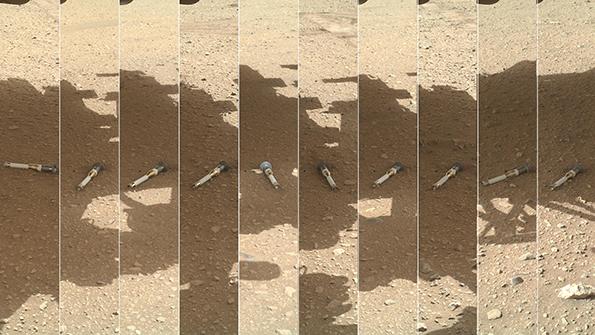This article is published in Aviation Week & Space Technology and is free to read until Jun 08, 2024. If you want to read more articles from this publication, please click the link to subscribe.
NASA Looks To Private Industry To Save Mars Sample Return Mission

A camera on the end of the Perseverance rover’s 7-ft. arm captured these images of sample tubes the rover deposited onto the surface of Mars. The tubes contain a backup collection of rock cores
and regolith that could be recovered as part of a sample-return campaign.
Scientists have spent decades on a strategic search to determine if life ever existed on Mars, the most Earth-like planet in the Solar System. Technology demonstrations paved the way for missions to search for signs of past water, followed by a hunt for habitable environments and conditions where any evidence of life could be preserved. The efforts culminated in the ongoing Mars Perseverance rover mission, which is coring rocks and collecting regolith for return to Earth for analysis.
NASA is now pondering how to bring those samples home. A series of independent assessments determined the agency’s $6-7 billion estimate for the multispacecraft Mars Sample Return (MSR) campaign was about $4-5 billion short—and likely to take seven years longer than planned.
- The agency to award multiple $1.5 million study contracts
- Baseline mission costs balloon to $11 billion
NASA is turning to private industry for help. On April 16, the agency posted a request for information (RFI) soliciting studies that could produce cheaper, faster ways to return at least 10 sample tubes from the Perseverance cache. Multiple study contracts, each worth $1.5 million, are expected to be awarded in July.
“We are committed to retrieving the samples,” NASA Administrator Bill Nelson told reporters on April 15. “The bottom line is that $11 billion is too expensive, and not returning samples until 2040 is unacceptably too long.”
Consistently characterized as a high scientific priority by the National Academies of Sciences, Engineering and Medicine, the return of samples to Earth for analysis using the latest laboratory technologies could reveal whether the red planet once hosted biological activity, as well as more information about the evolution of the Solar System.
In partnership with the European Space Agency (ESA), NASA had hoped to launch the next leg of the MSR campaign in time for the Perseverance collection to be back on Earth in 2033. The rover landed in 2021 inside Jezero Crater, which contains an ancient, well-preserved river delta. So far, Perseverance has gathered 24 of 38 potential samples of rock, soil and the Martian atmosphere in small, airtight containers, as well as 3-5 samples intended to document the possible presence of Earthly contamination. Ten samples have been cached on the surface of Mars as backups. The rest remain onboard the rover.
NASA’s baseline plan to return the samples involved launching a spacecraft in 2028 that would land near the rover for transfer of about 30 collection tubes into a canister for return to Earth. An ascent vehicle—the first rocket to launch from another planet—would transport the sample canister to an awaiting spacecraft in Mars orbit, the Earth Return Orbiter developed by ESA. Upon reaching Earth, the sample canister would be deployed for a parachute-assisted landing in the Utah desert in 2033.
NASA is looking for lower-cost MSR options to avoid having to siphon funds from other major science missions in development, including the Near-Earth Object Surveyor, an infrared space telescope designed to find and track asteroids that could pose an impact threat to Earth; Dragonfly, a mission to explore Saturn’s largest moon, Titan; and Veritas, a mission to explore the possible past habitability of Venus.
“What we’re hoping is that we will be able to get back some more traditional, tried-and-true architectures—things that do not require huge technological leaps but that have a high heritage and thereby can lower the risk, cost and also the time for development,” says Nicola Fox, associate administrator for NASA’s science mission directorate.
Nelson notes that the agency is struggling under the budget constraints imposed by the Fiscal Responsibility Act signed into law in June 2023 to raise the debt ceiling. NASA spending has been cut by $2.5 billion for fiscal 2024, including a $1 billion cut to the science portion of its budget.
“We can’t do everything,” Nelson says. “Otherwise you have to go and cannibalize from other missions. That is what has brought us to this point. I’m very hopeful that when we get around to the appropriations for a fiscal year 2026 budget, we will not be under those constraints, and we can ramp up our science funding for NASA.”
The agency had requested $949 million for MSR development during the current fiscal 2024 but received $310 million to pursue alternative strategies.
Responses to NASA’s RFI are due May 17. The agency intends to assess the proposals to select those most promising for 90-day contract awards for further analysis.






